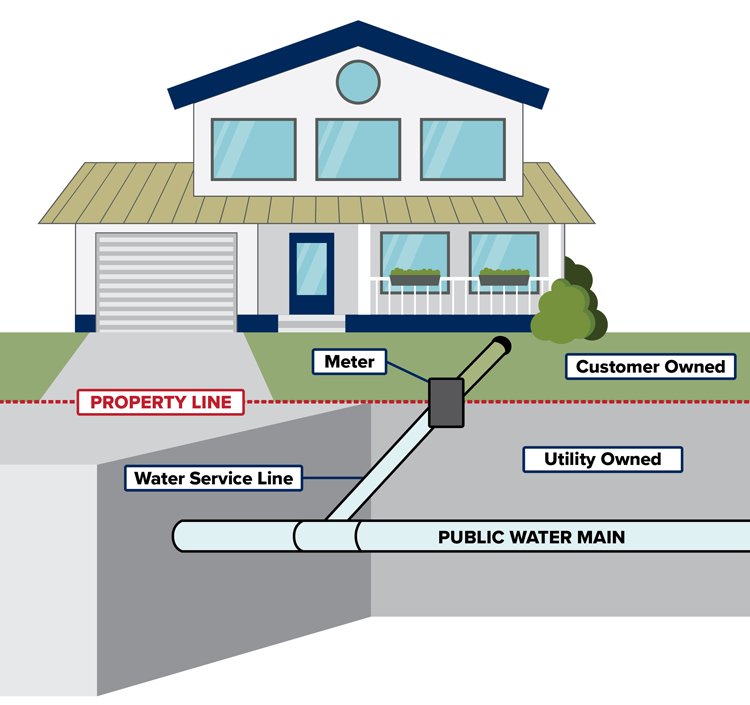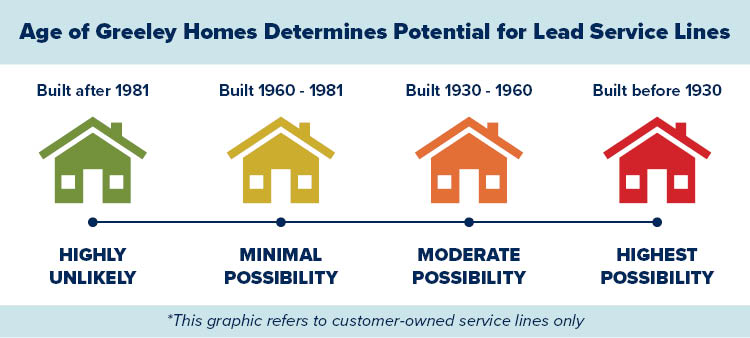Lead and Drinking Water
Greeley Water’s top priority is to provide safe drinking water and protect public health. In recent years, there has been greater national awareness of the potential health risks of lead in drinking water. The water leaving Greeley’s treatment facilities is lead-free, and our water testing confirms that lead does not come from our water supplies or the city’s water delivery pipelines. However, lead may be present in older homes’ plumbing and service lines, and we are working with customers to identify and reduce those risks.
Lead Protection Radio Interviews
September 20, 2023 – Michaela Jackson
Michaela Jackson, water quality and regulatory compliance manager, talks about the city’s lead protection program on KFKA.
CLICK HERE TO LISTEN
Help us Determine if You Have a Lead Service Line
- Complete the Service Line Questionnaire if your home was built before 1981.
- Those living in homes built after 1981 do not need to complete the questionnaire.
- Customers will be asked to provide information and photos of where the service line enters the house. Contact us if you need assistance at leadprotection@greeleygov.com or 970-336-4273.
- If the results indicate a potential lead service line, the city will follow up to coordinate the next steps. Having a lead service line does not necessarily mean you have lead in your water.
It's Important to Identify Presence of Lead
Prior to 1981, lead piping was sometimes used for the service lines that connect older homes to the city’s water system. As water runs through lead service lines or plumbing, the lead can dissolve or break off into tiny particles – ending up in drinking water.
Exposure to lead over a long period may cause health effects, so it’s important to identify its presence and remove any source that may contaminate water as it enters a home or building. You can learn about potential health impacts here: https://www.epa.gov/lead/learn-about-lead.

See the Spanish version of the above graphic
As shown in this diagram, the city owns the service line that runs from the main water line to the property line. The customer owns the service line, which may include the curb stop and water meter, that runs from the property line into their house.
The Water & Sewer Department has already replaced all known lead service lines on the city’s side. However, there may still be sections that contain lead on the customer side of the water meter.
Inspection and Replacement Program Beginning in 2023
In early 2023, Greeley Water will begin inspecting and replacing customer service lines that are found to contain lead at no cost to the homeowner. The city will begin inspections at approximately 1,900 properties that have a higher probability of potential lead service lines. Customers at these locations will receive advance notifications about what to expect during the process. Having a lead service line does not necessarily mean a customer has lead in their drinking water. Part of the inspection process will involve water sampling and testing.
Based on the best available information including the age of homes and when laws were enacted to ban lead piping, this graphic shows the possibility of a house in Greeley having a lead service line.

See the Spanish version of the above graphic
- After 1981 = Highly Unlikely: Homes built after 1981 should not have lead service lines. In 1981, Greeley adopted the International Plumbing Code banning the use of lead in water service lines.
- 1960-1981 = Minimal possibility: Based on available data, homes built between 1960-1980 have minimal possibility of lead service lines and will be inspected in future phases.
- 1930-1960 = Moderate possibility and pre-1930 = Highest possibility: In the past, the City of Greeley has found lead service lines primarily in homes built prior to 1960 with homes constructed before 1930 having the highest possibility of service lines containing lead. These homes will be prioritized for the initial phase of inspections.
- Pre-1987 plumbing: Plumbing installed prior to 1987 could also contain lead or lead solder. Customers should inspect and replace older plumbing with certified lead-free fixtures, and consult with a licensed plumber for assistance.
While Greeley will begin with inspecting older homes, new EPA rules require all water utilities to create a mapped inventory of water service line materials throughout the city and make it publicly available by October 2024. This comprehensive inventory will guide Greeley’s program to replace any remaining lead service lines at no cost to the homeowner.